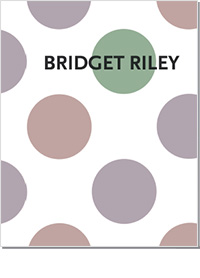 |
|
|||
Bridget Riley: Measure for Measure. New Disc Paintings Englisch Hardcover 24 x 30 cm 48 Seiten 30 Farbabbildungen 978-3-947127-06-1 vergriffen
|
Über ein halbes Jahrhundert nach ihren ersten bahnbrechenden Werken der Op Art in den frühen 1960er-Jahren arbeitet Bridget Riley noch immer an den Rändern der Wahrnehmung, untersucht die Interaktionen von Form und Farbe in ihren Gemälden. Für die Ausstellung Measure for Measure 2017 in der Galerie Max Hetzler in Paris installierte sie acht Leinwände und zwei Wandarbeiten, eine davon über vier Meter breit. In diesen Gemälden, Teil einer Serie von Disc Paintings (2016–2017), arrangiert sie auf einem diagonalen Raster farbige Kreise, deren Palette durch den pointilistischen Künstler George Seurat inspiriert ist – ein jeweils halbgraues Grün, Violett und Orange. Die Farbtöne changieren abhängig von der benachbarten Farbe und ihrer Position innerhalb des Rasters, was jeder Arbeit eine andere Stimmung verleiht. So ist diese Serie sowohl „das Ergebnis eines neuen Blicks, den Riley auf Seurat wirft“, als auch eine „Erkundung der visuellen Effekte, die sie durch die Wiederholung von in der Farbe variierenden Kreisformen auf einer begrenzten Oberfläche erreicht“, wie Éric de Chassey in seinem reich bebilderten Essay erläutert. Er beschreibt die unterschiedlichen Fragestellungen, mit denen Riley ihre Gemälde erst durch schwarzweiße, dann farbige Kreise über die Jahre entwickelt hat.
THE PLEASURES OF PERCEPTION Each Measure for Measure painting is a tour de force in mastering the chromatic divergences, so that they don’t rip apart the unity of a composition in establishing diversity into unity, and vice-versa. Riley had tried to do so in her earlier Circles Colour Structure Studies 1970/71 through the concentric enclosure of smaller discs inside larger circles, explaining then: ‘It is very important that each form finally relinquishes its separateness in the whole. It must be fully absorbed. So while it is necessary in the early stages to analyse each unit, my aim is to enable it to release sufficient energy to precipitate its dissolution in totality.’ This encircling was enough to establish diversity without letting it go astray, as already proven against the extreme regularity of the placement of black and white concentric circles in Dilated Centres (1963). The Measure for Measure series is proof that Riley is now able, through careful and intuitive placement of each greyed colour in an extremely regular composition, made of identical shapes, to work with separate forms that never relinquish their identity while never destroying the unity of the whole. On the contrary, the coloured circles, through a combination of regular repetition and specific variation, build up that unity from their separateness… In the square format of the Measure to Measure paintings and the two contemporary square wall paintings, there is no privileged direction, even if, because of the numbers of discs chosen, there is always a centre disc. Depending on the way I look at the painting, it appears centrifugal or centripetal (the square format also ensures that there is no spilling of the image onto the borders, that is to say the mind does not continue what it has learned inside the motif). It establishes a relationship to the body of the viewer: if I come close, I see most discs as a peripheral halo; if I step away, it performs as a picture (un tableau). The horizontal rectangular murals are much less centred, and they veer between stability and instability, agitation and harmony, anxiety and composure, depending on the way and the moment we look at them. The discs bump and bang, as if they were billiard balls or atoms, although fully bidimensional, and then they seem to be creating static patterns that our gaze isolates and combines to build a global field. They model organised randomness or random organisation, which is very much like our lives: no centre, no centres, except in the sense that each disc always reads as a centre for our vision, around which the surrounding discs organise themselves; only axes.
... |